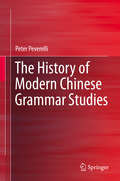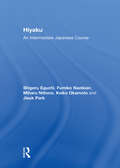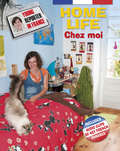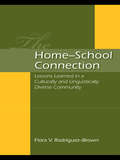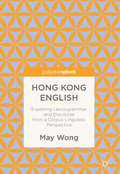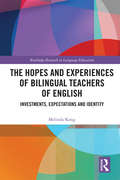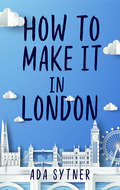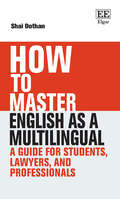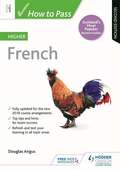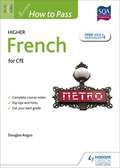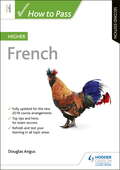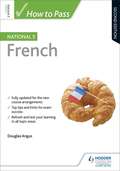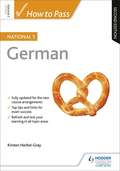- Table View
- List View
Historicizing Colonial Nostalgia: European Women's Narratives of Algeria and Kenya 1900-Present
by P. LorcinComparative study of the writings and strategies of European women in two colonies, French Algeria and British Kenya, during the twentieth century. Its central theme is women's discursive contribution to the construction of colonial nostalgia.
The History of Chinese Rhetoric (Routledge Studies in Chinese Discourse Analysis)
by Weixiao WeiThis book challenges the existing misconception that there was no rhetoric in ancient China. Instead, this book provides ample evidence from public speeches in the Xia dynasty and oracle bone inscriptions in the Shang dynasty to public debates about government policies in the Han dynasty to show that persuasive discourse and rudimentary rhetorical techniques already existed in ancient China. Using literary analysis and discourse analysis methods, this book explains how the Mandate of Heaven was inscribed at the core of Chinese rhetoric and has guided Chinese thoughts and expressions for centuries. This book also demonstrates Chinese rhetorical wisdom by extracting many concepts and terms related to language expression, persuasive speech, morality and virtue, life and philosophy, and so on from great Chinese literary works. Well-known names, such as Confucius, Laozi, Sima Qian, Liu Xie, Mozi, Hanfeizi, Guibuzi and so on, are all touched upon with their famous theory and sayings related to and explicated from the rhetorical perspective. Many surprising facts are found by the author and revealed in the book. For example, a thousand years ago, the Chinese author Liu Xie already found that all words have preferred lexical neighbors and structural environment. This is later on ‘discovered’ by corpus linguistics and illustrated, for example, by the concepts of collocation and pattern grammar. This book targets postgraduate students, teachers, researchers and scholars interested in advanced Chinese language and Chinese literature, history, and culture.
The History of Chinese Rhetoric (Routledge Studies in Chinese Discourse Analysis)
by Weixiao WeiThis book challenges the existing misconception that there was no rhetoric in ancient China. Instead, this book provides ample evidence from public speeches in the Xia dynasty and oracle bone inscriptions in the Shang dynasty to public debates about government policies in the Han dynasty to show that persuasive discourse and rudimentary rhetorical techniques already existed in ancient China. Using literary analysis and discourse analysis methods, this book explains how the Mandate of Heaven was inscribed at the core of Chinese rhetoric and has guided Chinese thoughts and expressions for centuries. This book also demonstrates Chinese rhetorical wisdom by extracting many concepts and terms related to language expression, persuasive speech, morality and virtue, life and philosophy, and so on from great Chinese literary works. Well-known names, such as Confucius, Laozi, Sima Qian, Liu Xie, Mozi, Hanfeizi, Guibuzi and so on, are all touched upon with their famous theory and sayings related to and explicated from the rhetorical perspective. Many surprising facts are found by the author and revealed in the book. For example, a thousand years ago, the Chinese author Liu Xie already found that all words have preferred lexical neighbors and structural environment. This is later on ‘discovered’ by corpus linguistics and illustrated, for example, by the concepts of collocation and pattern grammar. This book targets postgraduate students, teachers, researchers and scholars interested in advanced Chinese language and Chinese literature, history, and culture.
The History of Modern Chinese Grammar Studies
by Peter PeverelliThis book discusses the way Chinese scholars developed a national grammar. Chinese didn’t develop grammar until China’s contact with Western grammar books in the 19th Century. The first indigenous grammar was published in 1889. It included some traditional notions, but mainly imitated European grammar. It was followed by a number of other similar works. To move away from this imitation, a group of grammarians started to look into the Chinese tradition of commenting on classics. This led to a variety of alternative grammars. After the war, Western linguistics started to gain influence in China. With the establishment of the PRC in 1949, efforts began to have a standard grammar adopted nationwide. The first attempt at such a grammar was published in 1956. This book spans the period 1898 – 1956.This book combines historiography and linguistics to distinguish different periods in the timespan covered. It shows how the development of a national grammar cannot be studied separately from language policies and discussions on the national language. The description of each period includes a general introduction of the relevant events in that period and a treatment of the major works of grammar.
The History Of Spanish (PDF): A Student's Introduction
by Diana L. Ranson Margaret Lubbers QuesadaThis concise textbook provides students with an engaging and thorough overview of the history of Spanish and its development from Latin. Presupposing no prior knowledge of Latin or linguistics, students are provided with the background necessary to understand the history of Spanish. Short, easy-to-digest chapters feature numerous practice exercises and activities. Chapter 'Lead-in' questions draw comparisons between English and Spanish, enabling students to use their intuition about their native language to gain a deeper understanding of Spanish. Each chapter features further reading suggestions, an outline, and a summary. Highlighted key terms are collated in a glossary. Boxes on linguistic debates teach students to evaluate arguments and think critically about linguistics. Supporting online resources include Word files of all the practices and activities in the book and an instructor's manual featuring a sample syllabus, answer key to the practices and activities, sample exams and teaching suggestions. This book is ideal for a range of courses on the history of Spanish and Spanish linguistics.
Hiyaku: An Intermediate Japanese Course
by Shigeru Eguchi Fumiko Nazikian Miharu Nittono Keiko Okamoto Jisuk ParkHiyaku: An Intermediate Japanese Course provides a progressive intermediate course in Japanese, incorporating modern teaching methods and practicing all four language skills. Hiyaku provides content-based instruction, with authentic and semi-authentic dialogues and readings, all carefully selected to instruct and inspire students as they learn Japanese. Key features of the textbook include: highly structured chapters, beginning with warm-up exercises followed by focused practice of each of the four skills gradual introduction to increasingly authentic materials content taken from original Japanese sources such as books, TV programs, magazines, newspapers and websites extensive audio material provided as FREE MP3 files on a companion website instructor’s materials, including PowerPoint files provided through the companion website. Hiyaku does not simply teach language and basic cultural points: it also helps students gain a holistic understanding of Japanese society and history, and provides the necessary foundation for the advanced study of Japan and its language.
Hiyaku: An Intermediate Japanese Course
by Shigeru Eguchi Fumiko Nazikian Miharu Nittono Keiko Okamoto Jisuk ParkHiyaku: An Intermediate Japanese Course provides a progressive intermediate course in Japanese, incorporating modern teaching methods and practicing all four language skills. Hiyaku provides content-based instruction, with authentic and semi-authentic dialogues and readings, all carefully selected to instruct and inspire students as they learn Japanese. Key features of the textbook include: highly structured chapters, beginning with warm-up exercises followed by focused practice of each of the four skills gradual introduction to increasingly authentic materials content taken from original Japanese sources such as books, TV programs, magazines, newspapers and websites extensive audio material provided as FREE MP3 files on a companion website instructor’s materials, including PowerPoint files provided through the companion website. Hiyaku does not simply teach language and basic cultural points: it also helps students gain a holistic understanding of Japanese society and history, and provides the necessary foundation for the advanced study of Japan and its language.
Hölderlin’s Dionysiac Poetry: The Terrifying-Exciting Mysteries
by Lucas MurreyThis book casts new light on the work of the German poet Friedrich Hölderlin (1770 – 1843), and his translations of Greek tragedy. It shows Hölderlin’s poetry is unique within Western literature (and art) as it retrieves the socio-politics of a Dionysiac space-time and language to challenge the estrangement of humans from nature and one other.In this book, author Lucas Murrey presents a new picture of ancient Greece, noting that money emerged and rapidly developed there in the sixth century B.C. This act of monetization brought with it a concept of tragedy: money-tyrants struggling against the forces of earth and community who succumb to individual isolation, blindness and death. As Murrey points out, Hölderlin (unconsciously) retrieves the battle between money, nature and community and creatively applies its lessons to our time.But Hölderlin’s poetry not only adapts tragedy to question the unlimited “machine process” of “a clever race” of money-tyrants. It also draws attention to Greece’s warnings about the mortal danger of the eyes in myth, cult and theatre. This monograph thus introduces an urgently needed vision not only of Hölderlin hymns, but also the relevance of disciplines as diverse as Literary Studies, Philosophy, Psychology (Psychoanalysis) as well as Religious and Visual (Media) Studies to our present predicament, where a dangerous visual culture, through its support of the unlimitedness of money, is harming our relation to nature and one another.“Here triumphs a temperament guided by ancient religion and that excavates, in Hölderlin’s translations, the central god Dionysus of Greek tragedy.”“Lucas Murrey shares with his subject, Hölderlin, a vision of the Greeks as bringing something vitally important into our poor world, a vision of which few classical scholars are now capable.”—Richard Seaford, author of Money and the Early Greek Mind and Dionysus.“Here triumphs a temperament guided by ancient religion and that excavates, in Hölderlin’s translations, the central god Dionysus of Greek tragedy.”—Bernhard Böschenstein, author of “Frucht des Gewitters”. Zu Hölderlins Dionysos als Gott der Revolution and Paul Celan: Der Meridian.“Lucas Murrey takes the god of tragedy, Dionysus, finally serious as a manifestation of the ecstatic scream of liberation and visual strategies of dissolution: he pleasantly portrays Hölderlin’s idiosyncratic poetic sympathy.”—Anton Bierl, author of Der Chor in der Alten Komödie. Ritual and Performativität“Hölderlin most surely deserved such a book.”—Jean-François Kervégan, author of Que faire de Carl Schmitt?“…fascinating material…”—Noam Chomsky, author of Media Control and Nuclear War and Environmental Catastrophe.
Holocaust Intersections: Genocide and Visual Culture at the New Millennium
by Axel BangertRecent representations of the Holocaust have increasingly required us to think beyond rigid demarcations of nation and history, medium and genre. Holocaust Intersections sets out to investigate the many points of conjunction between these categories in recent images of genocide. The book examines transnational constellations in Holocaust cinema and television in Europe, disclosing instances of border-crossing and boundary-troubling at levels of production, distribution and reception. It highlights intersections between film genres, through intertextuality and pastiche, and the deployment of audiovisual Holocaust memory and testimony. Finally, the volume addresses connections between the Holocaust and other histories of genocide in the visual culture of the new millennium, engaging with the questions of transhistoricity and intercultural perspective. Drawing on a wide variety of different media - from cinema and television to installation art and the internet - and on the most recent scholarship on responses to the Holocaust, the volume aims to update our understanding of how visual culture looks at the Holocaust and genocide today. With the contributions: Robert S. C. Gordon, Axel Bangert, Libby Saxton- Introduction Emiliano Perra- Between National and Cosmopolitan: 21st Century Holocaust Television in Britain, France and Italy Judith Keilbach- Title to be announced Laura Rascaroli- Transits: Thinking at the Junctures of Images in Harun Farocki's Respite and Arnaud des Pallieres's Drancy Avenir Maxim Silverman- Haneke and the Camps Barry Langford- Globalising the Holocaust: Fantasies of Annihilation in Contemporary Media Culture Ferzina Banaji- The Nazi Killin' Business: A Post-Modern Pastiche of the Holocaust Matilda Mroz- Neighbours: Polish-Jewish Relations in Contemporary Polish Visual Culture Berber Hagedoorn- Holocaust Representation in the Multi-Platform TV Documentaries De Oorlog (The War) and 13 in de Oorlog (13 in the War) Annette Hamilton- Cambodian Genocide: Ethics and Aesthetics in the Cinema of Rithy Panh Piotr Cieplak, Emma Wilson- The Afterlife of Images
Holocaust Intersections: Genocide and Visual Culture at the New Millennium
by Axel BangertRecent representations of the Holocaust have increasingly required us to think beyond rigid demarcations of nation and history, medium and genre. Holocaust Intersections sets out to investigate the many points of conjunction between these categories in recent images of genocide. The book examines transnational constellations in Holocaust cinema and television in Europe, disclosing instances of border-crossing and boundary-troubling at levels of production, distribution and reception. It highlights intersections between film genres, through intertextuality and pastiche, and the deployment of audiovisual Holocaust memory and testimony. Finally, the volume addresses connections between the Holocaust and other histories of genocide in the visual culture of the new millennium, engaging with the questions of transhistoricity and intercultural perspective. Drawing on a wide variety of different media - from cinema and television to installation art and the internet - and on the most recent scholarship on responses to the Holocaust, the volume aims to update our understanding of how visual culture looks at the Holocaust and genocide today. With the contributions: Robert S. C. Gordon, Axel Bangert, Libby Saxton- Introduction Emiliano Perra- Between National and Cosmopolitan: 21st Century Holocaust Television in Britain, France and Italy Judith Keilbach- Title to be announced Laura Rascaroli- Transits: Thinking at the Junctures of Images in Harun Farocki's Respite and Arnaud des Pallieres's Drancy Avenir Maxim Silverman- Haneke and the Camps Barry Langford- Globalising the Holocaust: Fantasies of Annihilation in Contemporary Media Culture Ferzina Banaji- The Nazi Killin' Business: A Post-Modern Pastiche of the Holocaust Matilda Mroz- Neighbours: Polish-Jewish Relations in Contemporary Polish Visual Culture Berber Hagedoorn- Holocaust Representation in the Multi-Platform TV Documentaries De Oorlog (The War) and 13 in de Oorlog (13 in the War) Annette Hamilton- Cambodian Genocide: Ethics and Aesthetics in the Cinema of Rithy Panh Piotr Cieplak, Emma Wilson- The Afterlife of Images
Home Life (Young Reporter in France)
by Sue Finnie Daniele BourdaisMeet Ryan. He is in France on a special mission. He is going to find out about home life in France. Follow Ryan's blog to find out what French people like to eat, what family life is like and what their homes and towns are like.You can also learn some key French phrases, pick up French language tips and test your knowledge of France with the mini quizzes. Go to franklinwatts.co.uk for your free downloads of the French conversations.Home Life is part of the Young Reporter in France series. They are a great resource for the KS2 and 3 Framework for Languages which include an Intercultural Understanding strand where children compare and contrast life in other countries with their own.
The Home-School Connection: Lessons Learned in a Culturally and Linguistically Diverse Community
by Flora V. Rodriguez-Brown"In this unique contribution to the literature on parental involvement in culturally and linguistically diverse communities, Flora Rodríguez-Brown offers a critique of family literacy programs that lack a clear design for literacy activities relevant to community goals, offering an alternative model that is grounded within an abiding respect for the parents’ role as the child’s first, and ultimately, most important teacher." Robert D. Milk, University of Texas, San Antonio The Project FLAME program used as context for this book is a comprehensive family literacy model, supported by a strong sociocultural framework based on current research on cultural ways of learning and theories of multiliteracies and discourse. The model highlights the relevance of parents’ knowledge, cultural ways, and discourses in sharing literacy knowledge with their children. A pressing need exists for models and programs that effectively serve the educational needs of the steadily increasing numbers of culturally and linguistically diverse students in U.S. public schools today. Addressing issues related to development, implementation, and effectiveness of a program model that fulfills this need, this book is an essential resource for educators, community workers, and researchers interested in the relevance of the home-school connection in relation to children’s school success.
The Home-School Connection: Lessons Learned in a Culturally and Linguistically Diverse Community
by Flora V. Rodriguez-Brown"In this unique contribution to the literature on parental involvement in culturally and linguistically diverse communities, Flora Rodríguez-Brown offers a critique of family literacy programs that lack a clear design for literacy activities relevant to community goals, offering an alternative model that is grounded within an abiding respect for the parents’ role as the child’s first, and ultimately, most important teacher." Robert D. Milk, University of Texas, San Antonio The Project FLAME program used as context for this book is a comprehensive family literacy model, supported by a strong sociocultural framework based on current research on cultural ways of learning and theories of multiliteracies and discourse. The model highlights the relevance of parents’ knowledge, cultural ways, and discourses in sharing literacy knowledge with their children. A pressing need exists for models and programs that effectively serve the educational needs of the steadily increasing numbers of culturally and linguistically diverse students in U.S. public schools today. Addressing issues related to development, implementation, and effectiveness of a program model that fulfills this need, this book is an essential resource for educators, community workers, and researchers interested in the relevance of the home-school connection in relation to children’s school success.
Hong Kong English: Exploring Lexicogrammar and Discourse from a Corpus-Linguistic Perspective
by May WongThis book systematically examines the linguistic features and socio-cultural issues of ‘Hong Kong English’. The author focuses on authentic data taken from the International Corpus of English (the Hong Kong component) and the Corpus of Global Web-based English to track the ways in which the English language in Hong Kong has been adapted by its users. She also analyses the emergence of new forms and structures in its grammar and discourse. While the phonetic and phonological aspects of this variety of English have been well documented, its grammatical peculiarities and social language use have been hitherto neglected. This book offers original insights into the grammatical and pragmatic/discoursal features of Hong Kong English and will therefore be of interest to those working in fields such as World Englishes and corpus linguistics.
The Hopes and Experiences of Bilingual Teachers of English: Investments, Expectations and Identity (Routledge Research in Language Education)
by Melinda KongIn this age of internationalisation of higher education, many bilingual teachers from non-English-speaking contexts pursue their postgraduate degrees in English-speaking countries. Most programmes focus on providing content knowledge to them, while neglecting their investments. Furthermore, not much attention is given to what these bilingual teachers expect to gain from studying abroad, as well as their lived experiences and identity construction both inside and outside the classroom in English-speaking countries and when they return home. Nevertheless, these dimensions are crucial to their growth as teachers and users of English. This book explores these neglected aspects through case studies of bilinguals from various backgrounds. Through these case studies, the book examines the hopes, struggles and adaptation of bilinguals. It provides insights into what international students should realistically expect when studying overseas, and how to empower bilingual teachers, users and learners of English.
The Hopes and Experiences of Bilingual Teachers of English: Investments, Expectations and Identity (Routledge Research in Language Education)
by Melinda KongIn this age of internationalisation of higher education, many bilingual teachers from non-English-speaking contexts pursue their postgraduate degrees in English-speaking countries. Most programmes focus on providing content knowledge to them, while neglecting their investments. Furthermore, not much attention is given to what these bilingual teachers expect to gain from studying abroad, as well as their lived experiences and identity construction both inside and outside the classroom in English-speaking countries and when they return home. Nevertheless, these dimensions are crucial to their growth as teachers and users of English. This book explores these neglected aspects through case studies of bilinguals from various backgrounds. Through these case studies, the book examines the hopes, struggles and adaptation of bilinguals. It provides insights into what international students should realistically expect when studying overseas, and how to empower bilingual teachers, users and learners of English.
How to Augment Language Skills: Generative AI and Machine Translation in Language Learning and Translator Training
by Anthony Pym Yu HaoHow to Augment Language Skills outlines ways in which translators and language providers can expand their skillset and how translation technologies can be integrated into language learning and translator training.This book explains the basics of generative AI, machine translation, and translation memory suites, placing them in a historical context and assessing their fundamental impacts on language skills. It covers what to teach in a specific context, how to teach it, how to assess the result, and how to set up lively class discussions on the many problematic aspects. The exploratory empirical approach is designed to reach across several divides: between language education and translation studies, between technology designers and users, between Western and Asian research, and between abstract ideas and hands-on practice.Features include: Fifty-seven technology-related activities for the language and/or translation class. Recent research on the capacities of generative AI. Examples of how to conduct a needs analysis in the Higher Education context. Comparisons of the main teaching methods. Ways to assess the use of technologies. Examples in Chinese, Spanish, Catalan, French, and German. A full glossary explaining the key terms in clear language. Drawing on years of classroom experience, Pym and Hao illustrate how these skills can be taught in a range of classroom and online activities, making this essential reading for teachers and researchers involved in the teaching of languages and the training of translators.
How to Augment Language Skills: Generative AI and Machine Translation in Language Learning and Translator Training
by Anthony Pym Yu HaoHow to Augment Language Skills outlines ways in which translators and language providers can expand their skillset and how translation technologies can be integrated into language learning and translator training.This book explains the basics of generative AI, machine translation, and translation memory suites, placing them in a historical context and assessing their fundamental impacts on language skills. It covers what to teach in a specific context, how to teach it, how to assess the result, and how to set up lively class discussions on the many problematic aspects. The exploratory empirical approach is designed to reach across several divides: between language education and translation studies, between technology designers and users, between Western and Asian research, and between abstract ideas and hands-on practice.Features include: Fifty-seven technology-related activities for the language and/or translation class. Recent research on the capacities of generative AI. Examples of how to conduct a needs analysis in the Higher Education context. Comparisons of the main teaching methods. Ways to assess the use of technologies. Examples in Chinese, Spanish, Catalan, French, and German. A full glossary explaining the key terms in clear language. Drawing on years of classroom experience, Pym and Hao illustrate how these skills can be taught in a range of classroom and online activities, making this essential reading for teachers and researchers involved in the teaching of languages and the training of translators.
How To Make It In London
by Ada SytnerMy book is addressed to immigrants that came to the UK and want to find their first job or change their career path. It is dedicated also to English people if they want to change something in their life. Many people only dream about career satisfaction but doubt in their abilities. They can’t find a stimulus to make a first step forward, not knowing an English language enough. But this is not an ordinary guide, it is a key to success and real story of my career in UK. You will not find such a book in bookstores or in the Internet. Most of career guides concentrate around big steps and quick promotion, but this is good for people that have strong career in place and achieved a lot. What about people that are starting from the scratch? With little English knowledge and lack of professional experience on CV? In this book you will learn how to answer interview questions and learn English, how to write an attractive CV despite the lack of professional experience, I will also share list of 50 agencies. I came to London in 2004. I graduated here from University, where I have studied Finance. I work in City of London in a bank as an Analyst and Business Partner. Not only great work and money – it is also my ups and downs. Nobody is perfect, and my story proves that ordinary people also reach the stars, thus motivating their loved ones.
How To Master English as a Multilingual: A Guide for Students, Lawyers, and Professionals (How To Guides)
by Shai DothanBased on years of experience teaching English to non-native speakers, this insightful How To guide describes not only the particular challenges that multilinguals face compared to native English speakers but also the unique benefits of working in multiple languages.Throughout this engaging and practical book, Shai Dothan explores the mastery of the English language, reflecting on the common problem of perfecting your English whilst also practicing and refining other languages. This book serves as a guide to improving writing styles and presentation skills, especially of non-native English speakers by providing techniques for improved public speaking, reading, and writing. With an accessible approach, chapters teach a wide range of useful skills including how to excel in exams, publish in multiple languages, and develop your ‘inner ear’.Designed for multilinguals who wish to improve their English, this guide will be an invaluable and invigorating resource for students and researchers who are seeking to hone their English language skills. It can be used to accompany English language courses in an academic or professional setting and can also be read individually as a self-help book. Researchers, students, and professionals working in the field of law will find the book particularly relevant.
How to Pass Higher French: Second Edition (How To Pass - Higher Level)
by Douglas AngusExam Board: SQA Level: Higher Subject: French First Teaching: August 2018 First Exam: May 2019Get your best grade with comprehensive course notes and advice from Scotland's top experts, fully updated for the latest changes to SQA Higher assessment. How to Pass Higher French Second Edition contains all the advice and support you need to revise successfully for your Higher exam. It combines an overview of the course syllabus with advice from a top expert on how to improve exam performance, so you have the best chance of success.- Revise confidently with up-to-date guidance tailored to the latest SQA assessment changes - Refresh your knowledge with comprehensive, tailored subject notes- Prepare for the exam with top tips and hints on revision techniques- Get your best grade with advice on how to gain those vital extra marks
How to pass Higher French for CfE (PDF)
by Douglas AngusGet your best grade with the SQA endorsed guide to Higher French for CfE. This book contains all the advice and support you need to revise successfully for your Higher (for CfE) exam. It combines an overview of the course syllabus with advice from a top expert on how to improve exam performance, so you have the best chance of success.
How to Pass Higher French: Second Edition Epub (How To Pass - Higher Level)
by Douglas AngusExam Board: SQA Level: Higher Subject: French First Teaching: August 2018 First Exam: May 2019Get your best grade with comprehensive course notes and advice from Scotland's top experts, fully updated for the latest changes to SQA Higher assessment. How to Pass Higher French Second Edition contains all the advice and support you need to revise successfully for your Higher exam. It combines an overview of the course syllabus with advice from a top expert on how to improve exam performance, so you have the best chance of success.- Revise confidently with up-to-date guidance tailored to the latest SQA assessment changes - Refresh your knowledge with comprehensive, tailored subject notes- Prepare for the exam with top tips and hints on revision techniques- Get your best grade with advice on how to gain those vital extra marks
How to Pass National 5 French: Second Edition
by Douglas AngusExam Board: SQALevel: National 5Subject: FrenchFirst Teaching: August 2017First Exam: May 2018Get your best grade with the SQA endorsed guide to National 5 French.This book contains all the advice and support you need to revise successfully for your National 5 exam. It combines an overview of the course syllabus with advice from a top expert on how to improve exam performance, so you have the best chance of success.- Refresh your knowledge with complete course notes- Prepare for the exam with top tips and hints on revision technique- Get your best grade with advice on how to gain those vital extra marks
How to Pass National 5 German: Second Edition Ebook
by Kirsten Herbst-GrayGet your best grade with How to Pass National 5 German.Fully updated to account for the removal of Unit Assessments and the changes to the National 5 exam, this book contains all the advice and support you need to revise successfully. It combines an overview of the course syllabus with advice from a top expert on how to improve exam performance, so you have the best chance of success.- Refresh your knowledge with complete course notes- Prepare for the exam with top tips and hints on revision technique- Get your best grade with advice on how to gain those vital extra marks


